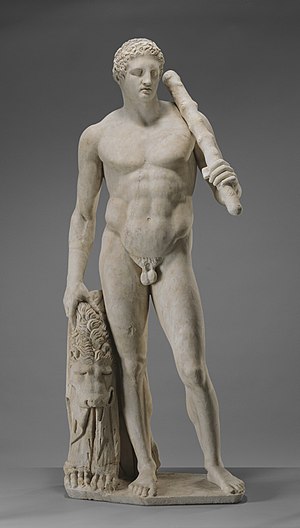Lansdowne Heracles
| Lansdowne Heracles | |
|---|---|
| Lansdowne Herakles | |
 | |
| Year | c. 125 (Julian) |
| Medium | marble |
| Dimensions | 193.5 cm (76.2 in) × 77.5 cm (30.5 in) |
| Location | US |
| Collection | J. Paul Getty Museum |
The Lansdowne Heracles is a Roman marble sculpture of about 125 CE. Today it is in the collection of the J. Paul Getty Museum's Getty Villa on the Malibu Coast, Los Angeles. The statue represents the hero Heracles as a beardless Lysippic[1][2][3] youth grasping the skin of the Nemean lion with his club upon his shoulder. The work was discovered in 1790 in Tivoli, Italy, on the site of Hadrian's Villa, where many fine Hadrianic copies and pastiches of Greek sculptures had been discovered since the 16th century. Today, the sculpture is considered to be an example of Roman-era improvisations on the Greek sculptural style of the fourth century BCE rather than a copy of a specific Greek original.[4][5]
The sculpture was found in the part of the villa's former site that had belonged to conte Giuseppe Fede. It was quickly acquired by Thomas Jenkins,[6][7] an English connoisseur and dealer in antiquities with deep connections to English aristocrats on the Grand Tour. In 1792, the statue was purchased by the first Marquess of Lansdowne. The statue had been fragmentary when rediscovered. It was restored at that time, as fragmentary sculptures did not appeal to neoclassical taste; the sculptor responsible, who was probably Carlo Albacini,[8] completed the statue's missing parts according to the sensibilities of the day: the nose was completed; the right forearm, several fingers, the rear of the lion's hide, part of the right thigh and the whole of the left calf were sculpted and assembled as discreetly as possible. The restorations were removed in the 1970s, after it was detected that iron and lead pins connecting the restorations to the original were swelling from corrosion and threatening to spall off additional pieces of marble. The 18th-century restorations were, in part, replaced with casts in epoxy resin, "to show the original as much as possible free of alien additions" according to the conservator Jerry Podany.[9] They have been re-integrated with the sculpture more recently.[5]
The sculpture remained at Lansdowne House, London, until the grand reception rooms were sheared off in a street-widening scheme. The Lansdowne sculptures were sold at auction in 1930.[10] The oil billionaire and collector J. Paul Getty bought the sculpture in 1951.[5]
Notes
[edit]- ^ Michaelis, Adolf (1882). Ancient Marbles in Great Britain. Cambridge: Cambridge University Press. p. 451.
This beautiful statue...exhibits the hero as of youthful age... In spite of the powerful square-built frame... the statue is unmistakeably in the spirit of Lysippos.
- ^ Stewart, Andrew (1995). Moon, Warren (ed.). Polykleitos, the Doryphoros, and Tradition ("Notes on the reception of the Polykleitan Style"). Madison: University of Wisconsin Press.
- ^ Frel, Jiří (1974). "A Hermes by Kalamis and Some Other Sculptures". The J. Paul Getty Museum Journal. 1. The J. Paul Getty Museum: 55–60..
- ^ Lattimore, S. (1975). "Two statues of Herakles". J. Paul Getty Museum Journal. 2: 17–26.
- ^ a b c Howard, Seymour (1978) [1966]. The Lansdowne Herakles. The J. Paul Getty Museum. pp. 17–21, 22 note 28. ISBN 0-89236-008-9.
- ^ Ford, Brinsley (1974). Sutton, Denys (ed.). "Six Notable English Patrons in Rome, 1750–1800 (Thomas Jenkins, Banker, Dealer, and Unofficial English Agent)". Apollo. 99: 408-461 (416ff).
- ^ Jenkins, Ian (1995). "Antiquity Restored. Essays on the afterlife of the antique". Journal of the History of Collections. 7 (1): 120–123. doi:10.1093/jhc/7.1.120.
- ^ Vaughan, G. (1991). "Albacini and his English patrons". Journal of the History of Collections. 3 (2): 183–197. doi:10.1093/jhc/3.2.183.
- ^ Muñoz Viñas, Salvador (2005). Contemporary Theory of Conservation. Oxford: Elsevier Butterworth-Heinemann. pp. 95–97.
Thus, for the sake of truth, authentic imprints of real history (in this case, the substantial work of a neoclassical sculptor) were removed due to them being considered alien to the object.
- ^ Catalogue of the celebrated collection of ancient marbles, the property of the most honorable the marquess of Lansdowne. London: Christie, Manson & Woods. 1930-03-05.
